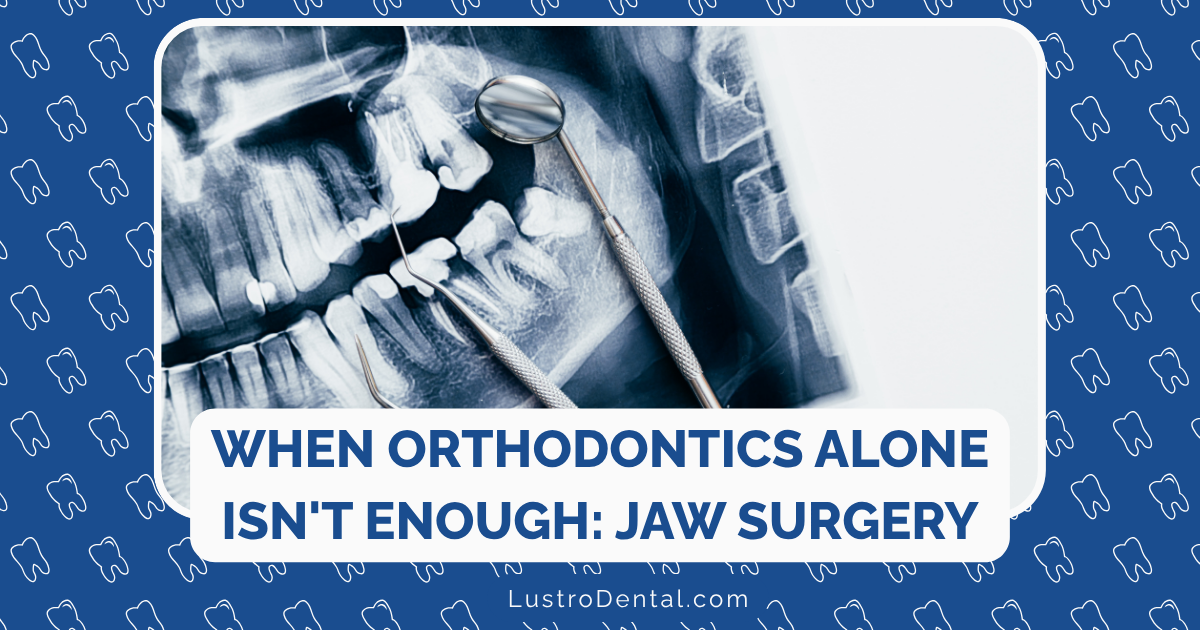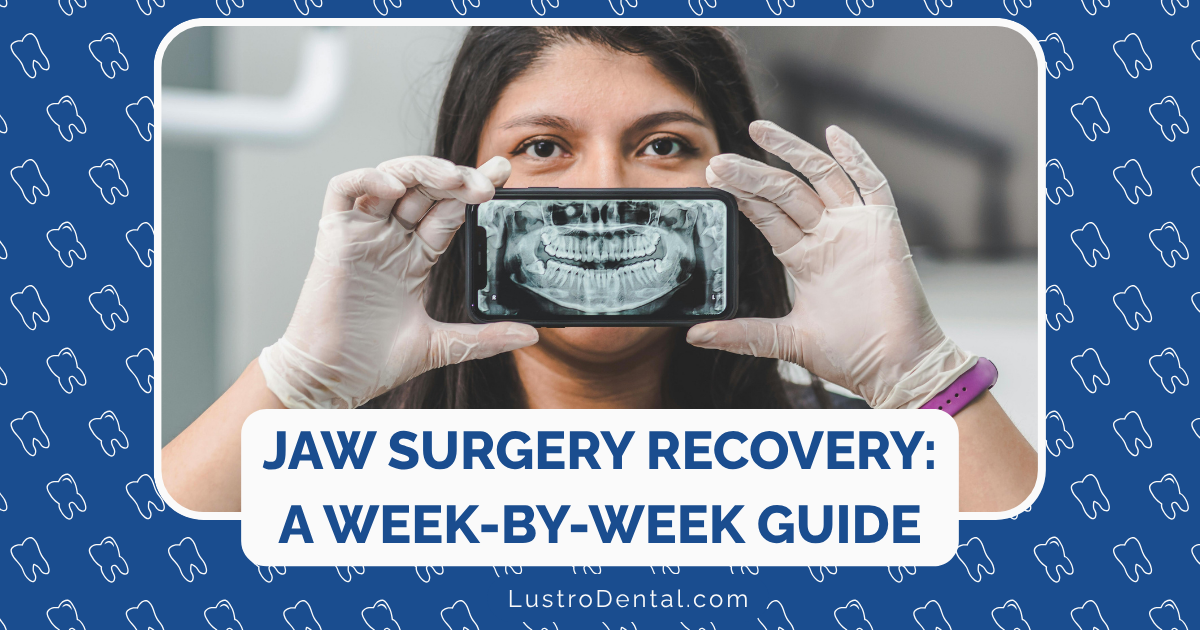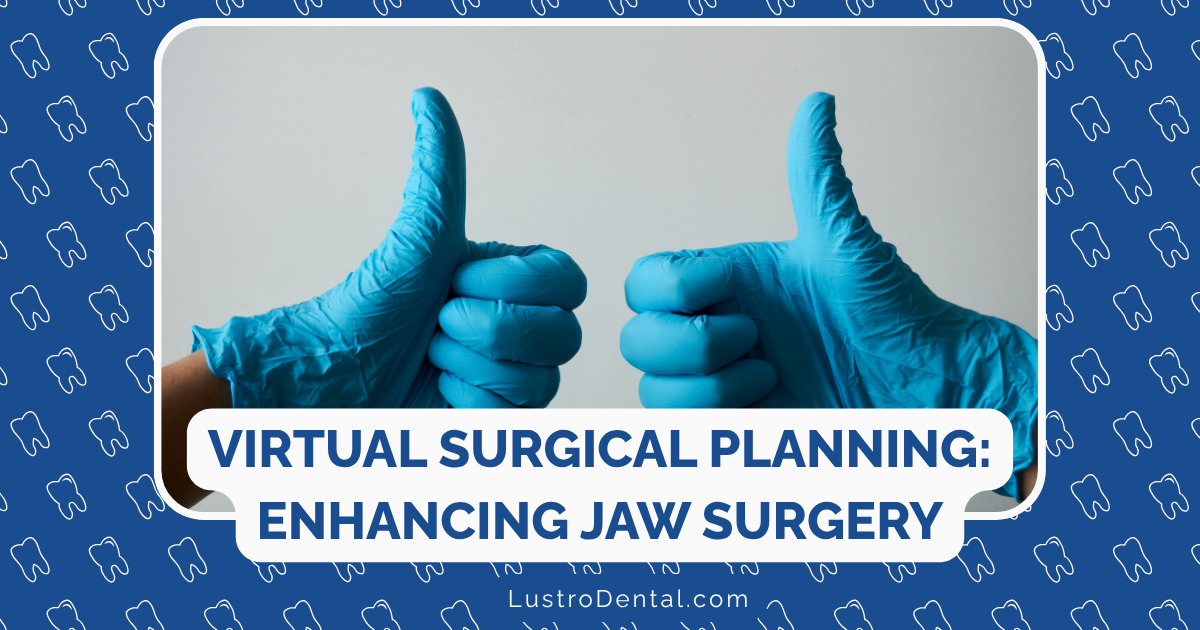Beyond Braces: When Jaw Surgery Is Necessary for Optimal Results

When most people think about orthodontic treatment, they envision braces or clear aligners gradually shifting teeth into proper alignment. For many patients, these traditional orthodontic approaches are sufficient to achieve a beautiful smile and proper function. However, there’s an important subset of orthodontic cases where braces alone simply aren’t enough.
For patients with significant skeletal discrepancies—where the upper and lower jaws don’t align properly due to their size or position—approach of orthodontics and jaw surgery combined treatment (orthognathic surgery) may be necessary to achieve optimal results. This comprehensive treatment not only improves appearance but also addresses functional issues that can affect breathing, speaking, eating, and overall quality of life.
In this article, we’ll explore when jaw surgery becomes necessary, what conditions typically require this approach, and what patients can expect throughout the treatment process.
When Braces Alone Aren’t Enough: Understanding Skeletal Discrepancies
Orthodontic treatment with braces or aligners works by moving teeth within the jawbone. However, these appliances can’t change the size, shape, or position of the jawbones themselves once a person has finished growing. According to the Mayo Clinic, jaw surgery becomes necessary when the upper and lower jaws have grown disproportionately, creating problems that can’t be corrected with orthodontic treatment alone.
The Difference Between Dental and Skeletal Issues
To understand when surgery might be necessary, it’s important to distinguish between dental and skeletal problems:
Dental Problems: These involve the position and alignment of teeth within normal jawbones. Issues like crowding, spacing, or rotated teeth typically respond well to traditional orthodontic treatment.
Skeletal Problems: These involve discrepancies in the size, shape, or position of the jawbones themselves. When severe, these issues often require surgical intervention in combination with orthodontic treatment.
Common Conditions That May Require Jaw Surgery
Several specific conditions often necessitate a combined orthodontic-surgical approach:
1. Severe Class II Malocclusion (Significant Overbite)
In this condition, the upper jaw significantly protrudes beyond the lower jaw, or the lower jaw is abnormally recessed.
When surgery might be needed:
- When the discrepancy is too large to be corrected with dental movement alone
- When the overjet (horizontal gap between upper and lower front teeth) exceeds 5mm
- When the condition causes functional problems with chewing, speaking, or breathing
2. Severe Class III Malocclusion (Significant Underbite)
This occurs when the lower jaw protrudes beyond the upper jaw, or the upper jaw is abnormally recessed.
When surgery might be needed:
- When the discrepancy is too severe for orthodontic camouflage
- When the ANB angle (a measurement of jaw relationship) is less than -4 degrees
- When there’s a negative overjet of several millimeters
According to a study in the Journal of Clinical and Diagnostic Research, patients with a Wits appraisal (another measurement of jaw discrepancy) of -12.1 ± 4.3 mm typically require surgical intervention rather than orthodontic treatment alone.
3. Open Bite
An open bite occurs when the front teeth don’t meet when the back teeth are closed together, leaving a vertical gap.
When surgery might be needed:
- When the open bite is skeletal in nature (related to jaw structure)
- When the vertical gap exceeds 2mm and doesn’t respond to orthodontic treatment
- When the condition causes significant difficulty with biting and chewing
4. Asymmetrical Jaw Growth
Sometimes jaws grow unevenly, resulting in facial asymmetry.
When surgery might be needed:
- When asymmetry exceeds 3mm with accompanying occlusal (bite) asymmetry
- When the condition causes functional problems or significant aesthetic concerns
- When the asymmetry is due to skeletal discrepancy rather than dental issues
5. Sleep Apnea Related to Jaw Position
Some cases of obstructive sleep apnea are related to jaw structure and position.
When surgery might be needed:
- When non-surgical treatments for sleep apnea have been ineffective
- When the condition is directly related to jaw position or airway constriction
- When the patient experiences significant daytime sleepiness or other symptoms
How Do Orthodontists Determine If Surgery Is Necessary?
Determining whether jaw surgery is necessary involves a comprehensive evaluation process:
1. Clinical Examination
Your orthodontist will examine your bite, facial proportions, and profile to identify potential skeletal discrepancies.
2. Imaging and Analysis
Several types of images and measurements help quantify skeletal issues:
- Cephalometric X-rays: These profile X-rays allow for precise measurements of jaw relationships
- Panoramic X-rays: These provide a broad view of all teeth and jaw structures
- 3D Cone Beam CT scans: These give a detailed three-dimensional view of bone structures
- Digital models: These allow for precise analysis of the bite
3. Functional Assessment
Your orthodontist will evaluate:
- Chewing efficiency
- Speech patterns
- Breathing function
- TMJ (jaw joint) health
- Overall comfort
4. Growth Consideration
For younger patients, your orthodontist will consider:
- Whether growth is complete (typically by age 16-18 for females and 18-21 for males)
- Whether growth modification might be an alternative to surgery
- How growth patterns might affect treatment outcomes
5. Consultation with Oral Surgeon
A maxillofacial surgeon will provide additional perspective on:
- Surgical feasibility
- Potential risks and benefits
- Recovery expectations
- Alternative approaches
The Combined Orthodontic-Surgical Treatment Process
When jaw surgery is deemed necessary, treatment typically follows this sequence:
Phase 1: Pre-Surgical Orthodontics (9-18 months)
During this phase, braces or aligners are used to:
- Align teeth within each jaw individually
- Position teeth optimally for surgery
- Often, this means teeth may temporarily look worse as they’re positioned for their post-surgical relationship
According to MedStar Health, this pre-surgical orthodontic phase typically takes 9 to 18 months.
Phase 2: Surgical Planning
As orthodontic preparation nears completion:
- Detailed records are taken, including new X-rays and 3D scans
- Virtual surgical planning may be used to simulate outcomes
- Surgical guides may be created to ensure precise jaw positioning
- The orthodontist and surgeon collaborate closely on the final surgical plan
Phase 3: Jaw Surgery
The surgery itself is performed under general anesthesia and may involve:
- Maxillary osteotomy: Repositioning the upper jaw
- Mandibular osteotomy: Repositioning the lower jaw
- Bimaxillary surgery: Repositioning both jaws
- Genioplasty: Repositioning the chin (sometimes performed alongside jaw surgery)
The specific technique depends on the individual case. According to Cleveland Clinic, orthognathic surgery has a success rate of nearly 94%.
Phase 4: Post-Surgical Recovery (6-12 weeks)
The initial recovery involves:
- Hospital stay of 1-3 days
- Significant swelling and discomfort for the first 1-2 weeks
- Liquid diet for approximately 4-6 weeks
- Gradual return to normal activities over 3-4 weeks
According to Apex Surgical, most patients gain complete strength and health after about six weeks post-surgery, though complete healing may take up to a year.
Phase 5: Post-Surgical Orthodontics (3-6 months)
After initial healing:
- Orthodontic treatment continues to fine-tune the bite
- Elastic bands may be used to guide teeth into their final positions
- Minor adjustments ensure optimal function and aesthetics
Phase 6: Retention
Once active treatment is complete:
- Retainers are provided to maintain the new tooth positions
- Regular follow-ups monitor stability
- Long-term retention is crucial to maintain results
The Patient Experience: What to Expect with Jaw Surgery
Understanding the patient experience can help set realistic expectations:
Before Surgery
- Emotional preparation: It’s normal to feel anxious about surgery. Many patients find it helpful to connect with others who have undergone similar procedures.
- Practical preparation: Prepare your home for recovery by stocking up on liquid foods, setting up a comfortable recovery space, and arranging for help during the initial recovery period.
- Financial planning: Work with your insurance provider to understand coverage. According to Aetna’s Clinical Policy Bulletin, orthognathic surgery is typically covered when medically necessary for functional reasons rather than purely cosmetic concerns.
Immediately After Surgery
- Hospital stay: Expect to stay in the hospital for 1-3 days for monitoring.
- Swelling and bruising: Significant swelling peaks around day 3 and begins to subside after 5-7 days.
- Liquid nutrition: A high-calorie, high-protein liquid diet is essential for healing.
- Pain management: Prescribed medications help manage discomfort.
Early Recovery (Weeks 1-6)
- Diet progression: Gradually transition from liquids to pureed foods to soft foods.
- Oral hygiene: Special care is needed to keep the surgical sites clean.
- Activity restrictions: Light activity can typically resume after 1-2 weeks, with a gradual return to normal activities.
- Follow-up appointments: Regular check-ups monitor healing and address any concerns.
Long-Term Recovery
- Sensation changes: Some numbness in the face or lips is common and typically resolves over 6-9 months.
- Jaw function: Jaw mobility improves gradually, with most patients achieving normal function within 3-6 months.
- Orthodontic adjustments: Braces or aligners continue to fine-tune the bite after surgery.
Real Patient Perspectives
While every patient’s experience is unique, these perspectives from real orthognathic surgery patients highlight common themes:
Sarah, 28 (Class III underbite correction): “The recovery was challenging for the first two weeks, but the results have been life-changing. I no longer have jaw pain when I eat, and I’m finally confident in my smile. Looking back, I wish I’d done it sooner.”
Michael, 35 (Open bite correction): “After years of trouble properly chewing food and being self-conscious about my smile, the combined orthodontic and surgical treatment has completely transformed my quality of life. The recovery period was a small price to pay for the lifetime benefits.”
Jennifer, 42 (Asymmetry correction): “I was nervous about having jaw surgery in my 40s, but my orthodontist and surgeon were incredibly supportive. The improvement in both function and appearance has boosted my confidence in ways I never expected.”
Weighing the Benefits and Considerations
Benefits of Combined Orthodontic-Surgical Treatment
- Functional improvements: Better chewing, speaking, and breathing
- TMJ health: Potential relief from jaw pain and dysfunction
- Airway enhancement: Possible improvement in sleep apnea and breathing issues
- Facial aesthetics: More balanced facial proportions
- Dental health: Better ability to maintain oral hygiene with properly aligned teeth
- Psychological benefits: Improved self-confidence and quality of life
Important Considerations
- Treatment duration: The entire process typically takes 18-36 months
- Recovery period: Initial recovery requires significant downtime
- Cost: Combined treatment is more expensive than orthodontics alone
- Potential risks: As with any surgery, there are risks including infection, nerve damage, and relapse
- Insurance coverage: Varies depending on medical necessity
When Surgery Might Be Avoidable
In some cases, alternatives to jaw surgery might be considered:
For Growing Children and Adolescents
Growth modification appliances (like headgear, functional appliances, or palatal expanders) may help guide jaw growth and potentially avoid the need for surgery later.
For Adults with Mild to Moderate Discrepancies
Orthodontic camouflage—moving teeth to compensate for skeletal discrepancies—might be an option in borderline cases, though this approach may compromise facial aesthetics or long-term stability.
Making an Informed Decision
If your orthodontist suggests that jaw surgery might be necessary, consider these steps:
- Seek comprehensive information about your specific condition and treatment options
- Consider getting a second opinion from another orthodontist or oral surgeon
- Ask to see before-and-after cases similar to yours
- Discuss realistic expectations for both aesthetic and functional outcomes
- Understand the financial aspects, including insurance coverage and payment options
- Connect with patients who have undergone similar treatment
- Weigh the long-term benefits against the temporary challenges of surgery and recovery
Conclusion: A Life-Changing Journey
The decision to pursue combined orthodontic and surgical treatment is significant, but for patients with severe skeletal discrepancies, it can be truly transformative. Beyond the aesthetic improvements, the functional benefits—better chewing, speaking, breathing, and overall comfort—can dramatically enhance quality of life.
If you’re facing this decision, remember that you’re not alone. Thousands of patients undergo orthognathic surgery each year with high satisfaction rates. The journey may be challenging at times, but the destination—optimal function and aesthetics that couldn’t be achieved with braces alone—is worth the effort for many patients.
Have you undergone orthognathic surgery or are you considering it? Share your experience or questions in the comments below.







